

19 14 26 30 Corporate Learning Expectations In The IT Industry In 2023 - Senthil Nayagam K, Hexaware Technologies Incivility, The Workplace Termite - Vibhuti Duggar, Project Purpose Protecting Learning Budgets At Times Of Recession - Venkat Subramaniam, Degreed Cultivating An Inclusive Work Culture To Enrich Employee Experiences - Deepika Pillai, Telus International Zyoin MARCH 2023 • Vol.5 • No. 02 (ISSN 2564-2049) NAvIgATINg LAyOffs IN A DIsRuPTIvE WORLD - Dr. Vidhya Thakkar, Asst. Professor, K J Somaiya Institute of Management
Navigating Layoffs In A
On the Cover
Articles
11 CHRO Corner
Exclusive interview with Sanchayan Paul, CHRO, Modenik
16 Turn The Great Breakup Into The Great Breakthrough!
Creating a culture of inclusivity in the workplace

- Gwen Kolader, Vice President, Hexaware Technologies
21 Coaching Your Way Out Of The Great Resignation
Leverage technology to make coaching scalable, accessible, and to increase employee morale

- Aradhana Srivastava, Head, Sales for Asia, EZRA
28 HR Trends To Build The Future Workplace
Adopt best practices that favor the right working conditions of an inclusive workplace
- Protima Achaya, HR Head & APAC Talent Acquisition, NetApp
32 Top 9 Reasons Why Training Fails And How To Fix Them
A guide to effective learning
- Uzair Hassan, CEO, 3H Solutions Group
08
INDEX HCM Excellence (APAC & Middle East) MARCH 2023 Vol.05 No.02 (ISSN 2564-2049)
Disruptive World
A guide to managing mental well-being for employees and employers - Dr. Vidhya Thakkar, Asst. Professor, K J Somaiya Institute of Management
TOP
PICKS
Corporate Learning Expectations In The IT Industry In 2023


Revamping corporate learning programs to retain talent and enable business growth
- Senthil Nayagam K, Chief Learning Officer and Global Talent Acquisition Head, Hexaware Technologies
Cultivating An Inclusive Work Culture To Enrich Employee Experiences


Diversity and inclusivity, the key drivers of overall organizational growth in the future
- Deepika Pillai, Director, HR, TELUS International
Incivility, The Workplace Termite
Improving workplaces globally by tackling the issue of workplace bullying
- Vibhuti Duggar, Founder, Project Purpose
19 26 30
Protecting Learning Budgets At Times Of Recession
Making a business case for continuous learning
- Venkat Subramaniam, President, Degreed
INDEX 14
How are our HCM Products and services helping to make you smarter?
HCM Excellence (APAC & Middle East) - Bi-monthly Interactive Learning Journal

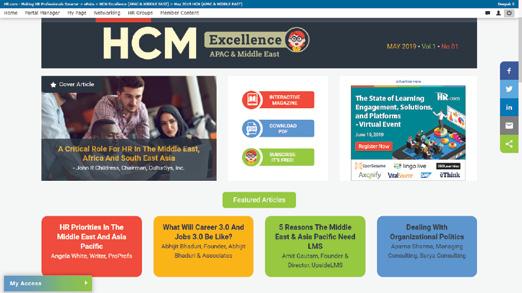
Stay up to date on labor laws and compliant on HCM regulations in the Asia Pacific (APAC) and Middle East regions. This bimonthly publication offers relevant topics that help educate and inform readers on the latest HR developments, regulations, or practices in these areas that may affect your business.
Human Capital Management Webcasts for Certification Credit

HR.com offers various informative webcasts on a variety of topics around human capital management. Webcasts are available live online with a downloadable podcast and a copy of the slides (PDF) available before and after each webcast. Earn all of the required recertification credits for aPHR, PHR, SPHR, GPHR, and SHRM Certifications. HR.com’s one-hour webcasts, excluding demo webcasts, in every HR specialty are pre-approved for HRCI and SHRM credit.

HR Community Networking
Join our community members with a similar interest in your specialty of HR. Share content and download research reports, blogs, and articles, network, and “follow” peers and have them “follow” you in a social network platform to communicate regularly and stay on top of the latest updates. These well-established communities are an invaluable resource for any HR professional or manager.
Use these invaluable HCM Excellence (APAC & Middle East) resources today! For more information phone: 1.877.472.6648 | email: sales@hr.com | www.hr.com
Driving and inspiring HR Excellence in the Asia Pacific and the Middle East regions.
Editorial Purpose
Our mission is to promote personal and professional development based on constructive values, sound ethics, and timeless principles.
Excellence Publications
Debbie McGrath CEO, HR.com - Publisher
Sue Kelley Director (Product, Marketing, and Research)
Babitha Balakrishnan and Deepa Damodaran Excellence Publications Managers and Editors
HCM Excellence (APAC & Middle East) Team
Babitha Balakrishnan and Deepa Damodaran Editors
Chinnavel Design and Layout (Digital Magazine)
Chandra Shekar and Vibha Kini Magazine (Online Version)
Submissions & Correspondence
Please send any correspondence, articles, letters to the editor, and requests to reprint, republish, or excerpt articles to ePubEditors@hr.com
For customer service, or information on products and services, call 1-877-472-6648
For Advertising Opportunities, email: sales@hr.com
Debbie Mcgrath Publisher, HR.com
Babitha Balakrishnan | Deepa Damodaran Editors, HCM Excellence (APAC & Middle East)



Inresponse to the workplace changes brought on by the 2019 pandemic, there has been an unparalleled surge towards remote work and flexible work arrangements in the past couple of years across various industries.
While this allowed companies to sustain their operations, it brought to the fore several underlying issues that are now posing threat to the world of work.
A concerning number of women have exited the workforce for a variety of reasons, while attrition and layoffs have reached an all-time high. Furthermore, there is now a new reality characterized by skills gap and scarcity of talent.
Investing in the right training programs to make new hires industry-ready, aligning learning and development (L&D) with human resources (HR) processes, and rewarding capability are essential to an organization’s career growth, retention, and succession planning in 2023 and beyond. Companies must also factor in growth strategies, such as upskilling and reskilling initiatives or soft skills training, to keep talent engaged and motivated.
Given the need for continuous learning to remain productive and up-to-date, in a world where unexpected disruptions can occur within a matter of months, L&D will play a key role in the success of an organization in the post-pandemic world.
HCM Excellence (APAC & Middle East) Excellence (ISSN 2564-2049)
is published monthly by HR.com Limited, 56 Malone Road, Jacksons Point, Ontario L0E 1L0
Website Address: www.hr.com
It is also important that companies prioritize empathy, civility, and inclusivity in their workplaces. Developing a culture that supports every level of staff is crucial for enabling team members to feel a sense of ownership towards the organization. At the same time, creating a safe and equitable environment, where diversity is embraced as a part of the work culture is essential for overall organizational growth. And, coaching will emerge as a powerful lever that can develop and advance workers at every level.
Copyright © 2023 HR.com. No part of this publication may be reproduced or transmitted in any form without written permission from the publisher. Quotations must be credited.
Investing in Talent: Prioritizing Learning, Empathy, and Inclusivity for Organizational growth
The March edition of HCM Excellence (APAC & Middle East) offers a range of insights for employers and employees. “Navigating Layoffs In A Disruptive World” by Dr. Vidhya Thakkar, Asst. Professor, K J Somaiya Institute of Management, Mumbai, India, is a guide to managing the mental well-being of employees and employers during layoffs. “Incivility, The Workplace Termite”, by Vibhuti Duggar, a Global Speaker, Corporate Trainer, and Founder of Project Purpose, highlights the issue of workplace bullying and offers ways to improve workplaces globally. In an exclusive interview, “The Key to Success Lies in Early Investment In the Right People and Processes”, Sanchayan Paul, CHRO, Modenik, discusses the growth of his career through his HR journey, from his early days to the present, and also delves into his experiences with workplace cultures and the various
challenges he faced in his personal development In “Cultivating An Inclusive Work Culture To Enrich Employee Experiences”, Deepika Pillai, Director of HR, at TELUS International, emphasizes diversity and inclusivity as key drivers of overall organizational growth in the future.
Check out “Coaching Your Way Out Of The Great Resignation”, where Aradhana Srivastava, Head of Sales, at EZRA, advocates leveraging technology to make coaching scalable, accessible, and to increase employee morale.

To sum up, it's crucial for companies to acknowledge that their employees are their most valuable resources and require cultivation, education, and encouragement to reach the organization's objectives. By emphasizing learning and development, empathy, respect, and diversity, companies can establish a robust employer brand reputation, draw in and hold onto exceptional talent, and ensure their sustained prosperity.
We hope you enjoy reading all the informative articles in this edition and get back to us with your valuable feedback!
Happy Reading!
Disclaimer: The views, information, or opinions expressed in the Excellence ePublications are solely those of the authors and do not necessarily represent those of HR.com and its employees. Under no circumstances shall HR.com or its partners or affiliates be responsible or liable for any indirect or incidental damages arising out of these opinions and content. EDITOR’s NOTE OR Subscribe now for $99 / year And get this magazine delivered to your inbox every month Become a Member Today to get it FREE! SIGN UP Write to the Editor at ePubEditors@hr.com
In a world of unparalleled challenges (global pandemic, racial injustice, political rivalry, digital 4.0, emotional malaise), uncertainty reigns. Finding opportunity in this context requires harnessing uncertainty and harnessing starts with reliable, valid, timely, and useful information. The Excellence publications are a superb source of such information. The authors provide insights with impact that will guide thought and action.

Excellence publications are my ‘go-to’ resource for contemporary and actionable information to improve leadership, engagement, results, and retention. Each edition offers rich and diverse perspectives for improving the employee experience and the workplace in general.





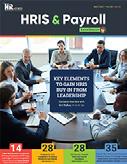
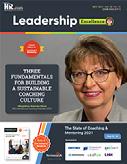
I regularly read and contribute to Leadership Excellence and Talent Management Excellence. I use many of the articles I read to augment my own presentations and I often share the articles with my clients. They are always quick, right on target for the latest issues in my field, and appreciated by my clients. If you want to stay up to date on the latest HR trends, choose a few of the different issues from the Excellence series of publications.

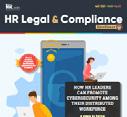



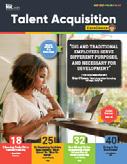

 Dave Ulrich
Rensis Likert Professor, Ross School of Business, University of Michigan Partner, The RBL Group
Julie Winkle Giulioni Author, Virtual /Live Keynote Presenter, Inc.’s Top 100 Leadership Speakers
Dr. Beverly Kaye CEO, BevKaye&Co.
Dave Ulrich
Rensis Likert Professor, Ross School of Business, University of Michigan Partner, The RBL Group
Julie Winkle Giulioni Author, Virtual /Live Keynote Presenter, Inc.’s Top 100 Leadership Speakers
Dr. Beverly Kaye CEO, BevKaye&Co.
WHY EXCELLENCE PUBLICATIONS?
We’re eager to hear your feedback on our magazines. Let us know your thoughts at ePubEditors@hr.com
Navigating Layoffs In A Disruptive World
A guide to managing mental well-being for employees and employers
 By Dr. Vidhya Thakkar, K J Somaiya Institute of Management
By Dr. Vidhya Thakkar, K J Somaiya Institute of Management
RJ Shraddha’s recent YouTube video on layoffs has been highly appreciated by one and all as it resonates with many people in the corporate world.
The start of 2022 saw a great resignation trend, and towards the end of 2022 and the beginning of 2023, the news floating all around was that of layoffs and hiring freezes, which will continue through the entire
year of 2023. Does this not seem like a revenge act? Employees left companies, and consequently, there was a talent crunch in companies, and now employers are telling employees to leave.
We truly are living in a disruptive world, where massive unexpected changes are taking place within a few months’ time. In India, edtech companies have laid off
Submit Your Articles HCM Excellence (APAC & Middle East) presented by HR.com March 2023 8
COvER ARTICLE
a maximum number of people while big technology giants and many others too have been trimming their workforce by giving them the pink slip. Meta, Twitter, Google, Microsoft, Amazon, Netflix, and Disney have always been dream organizations for people to work with, but the current layoffs in these organizations are only instilling fear in the minds of people who wish to work with such giants.
How to Manage your Mental Well-being During Layoffs?
Employee’s role - Every employee must craft their life on their own terms and not depend on their organizations to take care of them forever. The following are some of the important steps that every employee must practice during the layoff season:

Build Your Resilience Quotient
A direct result of layoff takes a toll on the mental health of the person and their dependents. The resilience quotient of a person can be best tested when they go through a layoff. Highly resilient people can tide over such a situation if they have saved enough and are not experiencing any financial setbacks and can cut corners in their expenses when the need arises. As a thumb rule, every person must save 30% of their earnings every month and have at least 6 months of living expenses as savings to tide over such times with little ease. Such financial security can certainly help in being more resilient to a disruptive economy and volatile job situations. This is more true for people in their mid-career stages who
have several responsibilities to fulfill and for whom job or career switches are not too easy. So, the habit of saving, from the initial stages of a career can go a long way in preserving mental well-being, which can easily get affected due to financial disruptions.
Cultivate Healthy Habits
During any setback in life, it becomes very easy to get into bad habits like alcohol and substance use, justifying it as a mood enhancer. It is important to consciously attempt to keep away from alcohol and all illegal substances and deal with the situation with more grace by adopting better habits. Exercising, cooking simple meals at home, and pursuing a low-cost hobby are the best mood enhancers that will rejuvenate a person to get better prepared for looking out for better opportunities in another organization.
Invest in Self-Reflection
Self-doubt, low self-esteem, and lack of confidence are direct results of a layoff. One can never stop asking, ‘Why Me?’ This could soon lead to anxiety and depression, which would be an additional setback to deal with. During a layoff, one must try not to ponder in self-doubt, but be proactive to look for various options and reflect on what new competencies they can develop during this available time. Channelizing our time towards self-development and skill enhancement can prove to be a boon when we start reapplying for jobs in organizations. The moment we strengthen our self-doubt, the more difficult it gets to find a job. So, if we need to get our life back to
Submit Your Articles HCM Excellence (APAC & Middle East) presented by HR.com March 2023 9 Navigating Layoffs In A Disruptive World
normalcy with a job, we must build more confidence. It helps to think that being laid off was not in our control but only due to external circumstances, which have also affected thousands of other people as well.
Network and seek Help
Finally, do not hesitate to reach out for help to a professional or any person you feel safe to talk to and open up about what you feel. Communication is the key to tiding over any difficult situation. Life is precious, and YOU matter a lot to the world.
Employer’s obligations -The employers too must fulfill their psychological contract towards their employees by following a few sensitive steps:
Transparency
If organizations have built their brands by advocating the mental well-being of their employees, then the time of layoffs is when they showcase how much they believe in their employees and their mental well-being. It is the responsibility of organizations to be transparent with their employees and prepare them for the exit. Obviously, companies do not take this decision overnight. It is a strategic decision, and everyone understands that they were forced to take such a harsh decision due to several macroeconomic reasons. But in what way such a decision is presented to the affected is in the hands of the organization. The mistake made by Better.com should not be repeated.
Being transparent with the employees and making them understand that the decision is a purely professional one and nothing personal, supporting the employees in whatever way possible in terms of helping them network to get another job, and giving good references could go a long way when an employee exits from the organization, in a calmer state of mind, which contributes a lot to a healthier society.
strategic Hiring Practices
For the long term, organizations must not be over-ambitious about their hiring practices and must not fill up positions when not required, especially when funding is available. Most edtech companies over-hired at high salaries and were not able to justify the same by bringing in necessary revenue.

These companies did not gauge the increasing competition, and their sales strategies were often only number-driven and less customer-driven. Companies must take their workforce planning activities more seriously and definitely align them with the organizational plans. Such concepts should not just be theoretical concepts but must be implemented in the true spirit to avoid any disruptions in the future as much as possible.
Career Management
If proper career planning and management processes are practiced in organizations, it helps employees get clarity on where they can go and grow in the organization in the future, and accordingly, the organization and employees can design their competency-building goals, which can help in avoiding layoffs. Such activities must be done continuously such that any external disturbances should be proactively addressed by making necessary changes in career management programs.
Finally, a layoff is just a phase in a person’s life and is not permanent. Self-belief is the key to tiding over this phase. Right from the career exploration stages, one must be prepared to face any unprecedented setbacks in life and must focus on building resilience along with adopting career-building strategies.
Even this will pass. Stay strong and increase your support circle.
Would you like to comment?
Submit Your Articles HCM Excellence (APAC & Middle East) presented by HR.com March 2023 10
Dr. Vidhya Thakkar (Ph. D) is an Asst. Professor at K J Somaiya Institute of Management, Mumbai, and provides career counseling to students, spanning over two decades in service. She has successfully helped students to choose careers based on their personalities and interests and showcases her expertise as a facilitator of various soft skills training programs.
Navigating Layoffs In A Disruptive World
“Human resources (HR) needs to know the business, the consumer, and the last-mile employee. One will get the invitation to the boardroom when one demonstrates one’s ability to raise the bar in the organization, show moral courage, and the ability to be the conscious keeper,” said Sanchayan Paul, Chief Human Resources Officer at Modenik Lifestyle.
For more than 25 years, Sanchayan has been an HR leader and holds corporate & entrepreneurial experience across Energy, Financial Services, Telecom, Tech Startups & Management Consulting. He brings significant experience in contributing to various aspects related to brand transitions, ownership changes, operating models, and M&As.
Sanchayan discusses the growth of his career through his HR journey, from his early days to the present, in an exclusive interview with HR.com. He also delves into his experiences with workplace cultures and the various challenges he faced in his personal development.

CHRO CORNER
Inspiring the Next Generation of HR Leaders
Where do HR leaders draw inspiration from? What are their worst nightmares? How did they stand the test of the changing times?
In this segment, we will trace your journey to the top.
This is your story - a story that is made of extraordinary accomplishments, methods that helped you overcome adversity, innovative programs that you led, and fundamental changes that you brought in. It's your chance to inspire the next generation of leaders.
Exclusive interview with sanchayan Paul, CHRO, Modenik
Excerpts from the interview:
What has your HR journey been like, and what influenced you the most to have a positive impact on your career?
sanchayan: Early on in my career, I was fortunate to get exposed to scale & complexity at the world’s largest grassroots refinery at Reliance Petroleum’s Jamnagar project. It was the world’s largest start-up, and being there, working on critical projects as a Management Trainee, prepared the base for me to manage both scale & size and start-ups & transformative projects.
From there on, working for Reuters, exposed me to global best practices, technology businesses, and world-class talent. My management consulting stint with Eicher Consulting, helped me build conceptual capability and look at solutions for business problems through the lens of structure & frameworks.
Vodafone (earlier Hutch/Orange) gave me amazing opportunities to partner with business units across 5 states
Submit Your Articles HCM Excellence (APAC & Middle East) presented by HR.com March 2023 11
Q.
of India, then as Head HR for India’s largest captive customer services center, and then in national roles heading Talent Acquisition & Employer Branding, and lastly as Head of Total Rewards & Org Effectiveness.
I was indeed lucky to lead some super-talented teams in Vodafone across shared services (SS), business partnering (BP), and Centers of Expertise (CoE).
Speed, Simplicity, and Trust are some of the organizational values that I imbibed. I loved working in an organization that transformed to grow. The change was a way of life & growing up. M&As, brand transformations, and scaling at speed – never made me realize how 14+ years flew by at Vodafone India
Building an employer brand, driving organizational effectiveness, and crafting a value-based, performance-driven culture at Vodafone India, made me extremely passionate about these subjects.
My failed entrepreneurial venture – on building a bluecollar job-tech platform – exposed me to the lives of India’s frontline/essential workforce and helped me better understand their needs. It made me humbler, upped my enterprise thinking and resilience, and I experienced the joy of experimenting.
Modenik’s stint has been about building enterprise and functional leadership teams, setting the foundational blocks of our people, culture, and identity, and aligning our shared purpose, and
values. We are now driving incredible transformation, digitization, and effectiveness.
What were your challenges during the early days of your career? What are those today?
sanchayan: In the very early days of my career, access to information, the absence of digitized data, and employee self-service tools were a challenge. But now, youngsters do so much more with the kind of data, digitization, and access to global information that we now have.
The challenges now are about offering the optimum solution to business problems, given that all the above are available in abundance and often draw one out in conflicting directions. Especially in the postpandemic world, the challenge is to make decisions while holding and appreciating conflicting perspectives while interacting with a multi-generational and diverse workforce, different employment and workplace models, and the changing dynamics of talent demand & supply.
How do you see workplace culture changing/evolving over the years/ decade?
sanchayan: There is more balance of power in the employer-employee equation. Employees have more choices & more security than they had a couple of decades ago.
Leaders are now driving culture with more empathy and by understanding nuances to customize solutions for colleagues and consumers, as opposed to the monolith decision-making center. Work culture is now more collective work, and leaders emerge in different situations and sub-sets of the organization to take the organization onward and toward growth.
It also means that organizations are more accepting of sub-cultures within the large organizational culture. Examples could be that your design teams may have a slightly different work culture when compared to the manufacturing department, both of which operate within the larger organizational purpose & value system.

Submit Your Articles HCM Excellence (APAC & Middle East) presented by HR.com March 2023 12
Q. Q.
CHRO Corner
Can you share the top three learnings/insights from the adversities/challenges you faced?
sanchayan: Investing in the right people & processes, early on is the key to success. Tough calls must be taken to make the right changes at the right time.
Having an emotional connection with your teams and knowing what motivates them deep within is the key to building a high-performing and engaged team.
Building bridges is important, not boundaries. Taking a functional outlook creates boundaries. Supply chain, marketing, sales, finance, and HR are just a continuum of business processes to serve the end consumer.
Where do you draw inspiration from? What do you have to say to those who are still struggling to find a place in the boardroom?
sanchayan: I draw inspiration from everyday experiences – from listening to podcasts to reading, to seeing some very young, inexperienced folks doing great work. And of course, there are a few leaders I see as role -models, and I try to pick what is the best in them.
Getting into the boardroom is only an outcome. Firstly, it is important to understand why one exists and one’s purpose in the organization.
HR needs to know the business, the consumer, and the last-mile employee. One will get the invitation when one demonstrates one’s ability to raise the bar in the organization, show moral courage, and the ability to be the conscious keeper. HR also needs to be exceedingly more & more data-oriented and numerically smart to claim a place on the table.
Where do you draw the line when it comes to work-life balance?
sanchayan: I firmly believe in work-life integration. I may sound old-world, but when I am doing what I want to do and am in the flow, I do not separate work and life as two separate compartments. I believe if you truly love what you are doing, you will not have a balancing problem.
Name: Sanchayan Paul
Designation: Chief Human Resources Officer
Company: Modenik Lifestyle Pvt Ltd
Total number of employees: ~ 5000
When did you join the current company: Dec 2020
Total experience in HR: 25
Hobbies: Reading, Writing, Cycling
What book are you reading currently: “Being Mortal: Medicine and What Matters in the End” by Atul Gawande.
What I do ensure is that my time for reading, cycling, food & entertainment, and time with family is planned and well attended to, especially during weekends.
What fundamental change(s) (in terms of culture) have you brought into your company?
sanchayan: Three big shifts:
1. Shared purpose & value-based culture;
2. Open, clear & transparent communication and;
3. Introduced a performance-driven, total rewards culture.
What are some major changes you see affecting HR within the next few years?
sanchayan: I see HR getting even more strategic in partnering with businesses. HR will also be at the forefront of driving these shifts towards digitization and more effective organizations. At the same time, HR will need to evolve to address matters of kindness in leadership, empathy in people managers, and ensuring the use of technology for the greater good.
Submit Your Articles HCM Excellence (APAC & Middle East) presented by HR.com March 2023 13
Would you like to comment?
Q. Q. Q. Q.
Q.
CHRO Corner
Corporate Learning Expectations In The IT Industry In 2023
Revamping corporate learning programs to retain talent and enable business growth
By Senthil Nayagam K, Hexaware Technologies
The information technology (IT) industry faced tremendous talent supply challenges, and the Great Resignation made the workforce a top priority. The war on talent increased employee costs, stressing over the profit and loss (P&L) statement for IT service providers in 2022. Talent retention and learning and development (L&D) emerged as the top strategic focus areas in the post-pandemic, high-demand scenario, with L&D becoming a critical business enabler.
A significant number of changes will persist beyond 2023 and into the future.
Preliminary Changes in Learning Programs
Skill demands are not incremental. A new set of skills will soon
replace skill sets that are in demand today. Skill expectations from existing roles are rising too. Companies need to rapidly reskill their workforce for current and future demands that are fungible to cater to demand variations from customers.
Like the evolving demand for skills, the norm for work models is also changing. Many employees expect remote working to continue in some shape and form. The disconnect from peer groups and organization influencers means companies must find newer ways to engage and motivate employees for continuous learning.
A great learning experience and development opportunities for all have become critical to retain talent. Companies with centralized knowledge hubs, where remote workers can easily find learning inputs for their job demands and
connect with peers and subject matter experts (SMEs) on the go, will successfully empower their remote workforce.
Adopting Measures to Increase Learning Experiences
Learning programs must be redesigned for speed and agility to cater to business demands.
Learners do not want learning to be prescriptive; they want it to be relevant as needed for their work. Chief learning officers (CLOs) must continue to inculcate a learning culture in the organization. Employees must experience the benefits of learning to increase its adoption. They need guidance to learn what is relevant for their career, trends, and demand visibility.
Socializing learning by building cohorts and mentoring programs while providing a great learning
Submit Your Articles HCM Excellence (APAC & Middle East) presented by HR.com March 2023 14
Businesses have undergone incredible changes in the past few years.
Top Pick
experience will remain a high priority in 2023. It is important to include employees in the design process and take ownership of their learning and development. Traditional L&D focused on formal learning, however, enabling employees to join and persist in formal learning programs was never easy. It is even more difficult with remote working and learning now.
CLOs must design and roll out programs that support social learning, cohort communities, on-demand digital learning, and knowledge-sharing sessions, and facilitate SME connections to support easy and effective learning.
Today, companies adopt a hire, train and deploy model. However, they soon realize that the return on investment (ROI) is not as expected with the high cost of new hires, training investments, and high attrition after training. To be sustainable, talent intake must be simplified to gain scale and cost advantage, and supported by L&D with smart programs to
rapidly upskill/cross-skill talent and make them billable.
Assessments for ‘fit for the role’ is vital to scale talent supply through training. Hands-on learning backed by evaluations is a must to ensure talent acceptance. Such test environments are not always readily available for all skill combinations, so companies must be ready to build their own, if needed.
The future of Workforce Development
Digital product engineering, distributed development and agile have witnessed massive growth recently. With traditional team structures gone, every team member must work independently and take ownership of their deliverables. This has spurned the need for behavioral development along with technical development as an integral part of workforce development.
There is a plethora of L&D tools, content, and providers, all vying for a CLO’s wallet share with employee headcount-based, enterprise pricing models. However, learner usage is often bite-sized and on the go, so the actual cost of learning tools per employee is rising. CLOs must carefully evaluate their choice of content, platforms, and tools to keep their employee development program cost reigned-in.
Measuring the effectiveness of learning programs is another priority for CLOs. Companies must invest and strengthen their systems and processes to get the
necessary data and insights that will help them measure the impact of their learning programs.
Companies are stepping up on fresh campus graduate intake to meet talent supply demand and reduce the average cost of workforce acquisition. They should smartly manage this talent pool, invest in the right training program to make them industry-ready on time, and have guardrails to retain and protect their investments. Thus, aligning L&D with human resources (HR) processes is critical for organizations.
Right L&D opportunities attract the right talent. Measuring and rewarding capability is an essential outcome of performance management and promotion that directly influences an organization’s career growth, retention, and succession planning.

Senthil Nayagam is Chief Learning Officer and Global Talent Acquisition Head at Hexaware Technologies. He leverages his vast experience in sales, delivery, and operations, to apply common-sense talent development strategies to make a high business impact.
Would you like to comment?

Submit Your Articles HCM Excellence (APAC & Middle East) presented by HR.com March 2023 15 Corporate Learning Expectations In The IT Industry In 2023
Turn The great Breakup Into The great Breakthrough!
Creating a culture of inclusivity in the workplace
By Gwen Kolader, Hexaware Technologies
McKinsey’s annual report, “Women in the Workplace 2022”, describes the concerning fact that women leaders are leaving corporate companies at the highest rates ever. Senior women leaders and the next generation of women leaders are quitting their jobs. They place a higher premium on working in an equitable, supportive and inclusive workplace. This fact is concerning enough, but
companies should be extra alarmed by the current war on talent.
The research shows that women, who aspire to develop from a professional into a manager or a leadership position will face challenges. For every 100 men who are promoted to leadership roles, only 87 women are promoted.

Submit Your Articles HCM Excellence (APAC & Middle East) presented by HR.com March 2023 16
Another fact from the report is that two female leaders will leave for every female promotion.
Deloitte also released a report this year focusing on “Women@Work, a Global Outlook”, based on a survey of 5,000 women across 10 countries. The responses indicate that the pandemic continues to take a heavy toll on women. Burnout, for example, has reached high levels. Many women have built careers driven by their experiences during the pandemic. For some, it meant leaving their employers or workforce entirely.
Why Do Women Leave in such High Numbers?
Women are as ambitious as men, but they face a corporate culture, where women are treated differently than men. There are multiple issues that women have to deal with in the workspace. For instance, microaggressions - being talked over, interrupted, or patronized. Deloitte’s report states that 50% of women say they have experienced microaggressions.
Another is ‘the always-on culture’ - over one-third of women rate their ability to switch off from work as poor/very poor, according to Deloitte’s report.
The third example from the McKinsey report is that women leaders want to work for a company that is more committed to employee well-being and diversity, equity & inclusion (DEI).

gender Equality in the Tech World Over the Past years
Deloitte Global predicts that global technology firms, on average, will reach nearly 33% female representation in their workforces in 2022, up slightly more than two percentage points from 2019.
A two-percentage-point increase might seem too small of a hike, but it does represent progress. Moving the needle is difficult, and requires aggressive campaigns to recruit, hire, retain, and promote women. While this progress is a step in the right direction, tech companies may need to work harder to improve these numbers.
Submit Your Articles HCM Excellence (APAC & Middle East) presented by HR.com March 2023 17 Turn The Great Breakup Into The Great Breakthrough!
How Can We Transform this great Breakup into the great Breakthrough?
Evaluate the leadership profile Institut Européen d’Administration des Affaires (INSEAD), a business school, takes a closer look at how the traditional leadership profile is still being looked at as being strong, directive, always available, putting work first, and taking charge. They mention that ‘thinking of leader’ is still ‘thinking of man’. Companies need to act against this culture as masculine job framing leads to biases in recruitment, evaluation, resource allocation, and promotion. It will hold women back. Companies that will not take action to combat stereotyping and bias will most likely be unable to create a gender-equitable company culture.
Get rid of the ideal worker profile
INSEAD also states that most talent management systems are based on the ideal worker profile. But the concept of an ideal worker in the past does not seem to fit anymore. The assumption of the ideal profile is based on employees being fully dedicated to work, having no family conflicts and being able to travel or move at a moment’s notice.
Today, it is rare to find either men or women who fit the traditional, outdated image of an ideal worker. This assumed model no longer applies in a world where individuals often balance dual careers while also desiring to raise children and maintain multifaceted lifestyles. Companies should reevaluate their underlying profile and talent framework to provide employees with opportunities and possibilities that match today’s world.
Flexible and hybrid work
The hybrid way of working creates a risk for those who are not physically present. According to the ‘Deloitte Women at Work 2022’ research, almost 60% of women who work in hybrid environments feel that they have been excluded from important meetings. INSEAD also states that the 24/7 work culture can enable flexibility. However, in reality, flexible working is stigmatized in most organizations. Leaders focusing on equality and equity in their cultures have women report far more positive experiences with hybrid working. Only 14%
have felt excluded from meetings and only 7% say they need more exposure to leaders.
Men allyship programs
An HBR article describes how men and women experience allyship from men in the workplace for gender equity. Men rate their involvement as allies much higher than women do.
The Integrating Women Leaders Foundation (IWL) states that implementing allyship programs for men is a good solution to fight these differences and increase equality. Men, who participate in allyship programs, appear to be more aware and likely to mitigate gender inequity and inequality.
Women leave companies because they no longer accept a work environment where their ambitions and gender equality and equity are not encouraged. Companies that do not step up may struggle to recruit and retain women, especially the next generation. Companies that understand what gender equality and equity truly mean will be able to turn this Great Breakup into the Great Breakthrough.
Would you like to comment?

Submit Your Articles HCM Excellence (APAC & Middle East) presented by HR.com March 2023 18
Gwen Kolader is a People & Culture advocate, Global Head of DEI, and Vice President at Hexaware Technologies and Mobiquity. She practices inclusive leadership and strives for a more equitable workplace environment, where everyone feels a sense of belonging.
Turn The Great Breakup Into The Great Breakthrough!
Cultivating An Inclusive Work Culture To Enrich Employee Experiences
Diversity and inclusivity, the key drivers of overall organizational growth in the future
By Deepika Pillai, Telus International Zyoin
Diversity and inclusivity started garnering traction a couple of years back when the corporate world adapted to a work-from-anywhere model, resulting in hiring talent across borders. The trend is now gaining momentum in India as companies aim to create a safe workplace for all. As organizations

begin to make efforts by taking active steps, the government further extends its support by introducing policies to make diversity, equity, and inclusion (DEI) a reality for the country.
India, which is home to 1.4 billion people, has the highest youth
population, and corporates in India have realized that the younger demographic prefers to work in an organization that is diverse and inclusive. Many workplaces are seeing the coming together of various generations, such as boomers, millennials and Gen Z, under one roof, and
Submit Your Articles HCM Excellence (APAC & Middle East) presented by HR.com March 2023 19
Top Pick
have realized that they need to implement change in response to this paradigm shift.
For example, at TELUS International, we are committed to listening, learning, and embracing different perspectives and experiences – to cultivate a culture where everyone belongs. We believe the right to DEI practices promotes higher retention, engagement, innovation, drives a better work culture, improves profits, and helps us support communities around us better.
The organization’s culture, policies, and practices should be built to make sure team members coming from diverse backgrounds, such as race, sex, age, origin, culture, economic status, education, seniority levels, job levels, etc., feel welcomed as a part of the organization. Despite diverse backgrounds, everyone should be treated fairly and respectfully. They should be encouraged to share opinions and voice their feedback. Employers should be committed to creating equal opportunities for all team members where they feel driven towards a common purpose.
As every organization is unique, its DEI initiatives should be tailor-made to cater to its employees. The possibility of companies failing to achieve their workplace inclusivity and diversity goals is high when they are borrowed from somewhere else. Implementing any new change in an organization needs to be driven top-down. Leadership teams
should implement diversity and inclusivity as part of the company policy alongside fostering a culture of belongingness for all the internal stakeholders. When employees see positive changes in top management, they automatically believe they feel safe and secure.
Human resource (HR) departments should work with senior leadership teams to devise tools and tactics to ease the implementation of DEI policies. Sensitizing internal stakeholders on how to operate in diverse communities can inculcate a supportive attitude toward co-workers.
Organizations can design engaging workshops for employees, educating them on how to work with diverse teams. In addition to training sessions, they can also look at mentoring sessions and soft skills coaching, offer therapy sessions, and create support groups where employees can safely raise their concerns. Team members should be encouraged to form interest groups of their choice within the organization to feel valued and have fun at work. Gratifying, recognizing, and rewarding employees who actively contribute toward the company’s overall DEI goals can create a win-win for all. Creating and implementing diversity and inclusivity policies are not just enough. Companies should aim to create a conducive work environment for all employees which makes them stay. To ensure this, organizations should conduct regular employee
surveys to help the company understand how they can further strengthen their DEI initiatives and take necessary actions to improve the company culture.
Diversity and inclusivity will be the key drivers of overall organizational growth in the future. Stay committed to ensuring that every team member is valued, their contributions are recognized, and they can thrive in a safe and equitable environment. Leadership that imparts DEI policies through strategic implementation encourages its workforce to embrace diversity as a part of its work culture, creating a win-win situation for all.
Deepika Pillai is the Director of
at
International With over two decades of HR management experience, Pillai actively participates and leads communities, taking up initiatives, such as planning, leading, directing, developing, and coordinating DEI policies and activities, that resonate with the company’s vision.
Would you like to comment?

Submit Your Articles HCM Excellence (APAC & Middle East) presented by HR.com March 2023 20
Cultivating An Inclusive Work Culture To Enrich Employee Experiences
HR
TELUS
Coaching your Way Out Of The great Resignation
Leverage technology to make coaching scalable, accessible, and to increase employee morale
By Aradhana Srivastava, EZRA
In the aftermath of the Covid-19 pandemic, employees around the globe continue to re-evaluate their priorities and values when it comes to work, triggering a wave of resignations in organizations across every industry. This phenomenon shows no signs of abating, with 25% of workforce in Asia-Pacific considering switching organizations this year.
Factors Contributing to No-Confidence and Consequent Resignations
There is a growing disconnect between HR leaders and employees in understanding what workers value in the workplace as employee expectations continue to evolve. While compensation remains important, workers are increasingly prioritizing nonmonetary factors and incentives including workplace culture, employee well-being, and flexible working arrangements, leading them to switch jobs if these priorities are unmet. This is especially true for Millennials and Gen Zs, who place great importance on having a sense of purpose and finding value in their work.
However, seven out of 10 leaders in Asia-Pacific believe their companies will be forced to wind back
progress on flexible working, skills development, and employee well-being with the looming recession1
Burnout is another contributor to the high number of resignations in the region, with more than nine in 10 workers experiencing burnout in Singapore2. Feeling undervalued can also contribute to the growing dissatisfaction among workers with their jobs, leaving them less engaged.43% of employees in the region reported that they are unhappy with their jobs3, hinting at a possible next wave of resignations in the coming months. Compounded by the talent shortage in Asia and around the world, it is crucial for HR leaders to now consider implementing strategies that improve workforce retention before it is too late.
Measures to Employ to Improve Talent Retention
One way to improve talent retention is through coaching – a practice traditionally reserved for a company’s C-suite. Coaching is an evolving concept in Asia-Pacific and is becoming increasingly relevant as a retention strategy in a rapidly changing business and human resources (HR) landscape.
Submit Your Articles HCM Excellence (APAC & Middle East) presented by HR.com March 2023 21
Coaching serves as a powerful tool that helps employees maximize their potential and realize their greatest ambitions in the workplace. Today’s employees are focused on professional development but the lack of opportunities when it comes to reskilling can be a push factor for employees to leave their job. This trend is even more prominent amongst the younger generations, with almost three-quarters of Millennial and Gen Z workers planning to quit their jobs in 2023 due to a lack of these opportunities.
Fostering a culture of self-improvement in the workplace can go a long way in developing and retaining talent. Providing employees with opportunities to grow and learn will empower them to develop their knowledge, skills, capabilities, and help them to be more effective in their jobs.
The skills required for jobs continue to rapidly evolve during economic transformation, and it is vital for companies to provide the necessary
support for their employees. Charles Darwin said, “It is not the strongest of the species that survives, nor the most intelligent, but the one most responsive to change.” Getting professional support in developing soft skills, such as resilience and adaptability, through personalized coaching sessions gives employees the tools needed to cope with the rapid rate of change and ongoing economic uncertainty.
Boosting the sense of Belonging Among Employees
Beyond guiding employees in their professional development, coaching also helps employees feel recognized and valued. While remote work has given employees greater flexibility, it has also given rise to more workers feeling overlooked and undervalued for their contributions to the company.
Investing in coaching can help demonstrate to employees that management is committed to their long-term growth within the organization by giving them access to personalized guidance

Submit Your Articles HCM Excellence (APAC & Middle East) presented by HR.com March 2023 22
Coaching Your Way Out Of The Great Resignation
from professionally trained coaches to aid in their career development. Coaching has proven to be an effective talent retention strategy for organizations across the globe, with companies who have provided coaching reporting a 14% improvement in retention rates after completing a program4.
With virtual coaching, employees can have oneto-one coaching sessions regardless of their location or language, and scheduling sessions can be done in a matter of seconds.

Organizations can also measure employees’ progress by keeping track of the objectives and key results (OKRs) employed alongside the coaching program. Participants can track competency-specific progress and make improvements without compromising on the confidentiality of coaching sessions to
measure the effectiveness of the same in their organization.
In a post-pandemic world, where workers’ priorities and values have significantly shifted, companies must pay greater attention to the needs of their employees and find new ways to motivate them beyond looking at financial incentives. People are an organization’s greatest assets and coaching is a powerful lever that can develop and advance workers at every level. Doing so will coach them out of the Great Resignation.
1. https://www.cnbc.com/2022/11/11/great-resignation-linkedinsays-india-singapore-australia-hiring-slows.html
2. Ceridian, 2022 Pulse of Talent Report
3. PwC Asia Pacific Workforce Hopes and Fears Survey 2022
4. EZRA Insight Report Q3 2021
Aradhana Srivastava is the Head of Sales for Asia at EZRA. She is responsible for setting up new businesses across Asia while managing regional teams and driving acquisition strategies across the continent. Srivastava brings more than 16 years of experience in the L&D space and is a strong advocate for democratizing coaching. Srivastava strives to help more people unlock, develop, and grow their management skills.
Would you like to comment?

Submit Your Articles HCM Excellence (APAC & Middle East) presented by HR.com March 2023 23 Coaching Your Way Out Of The Great Resignation
HRCI® & SHRM® CERTIFICATION PREP COURSES
GROUP RATES AVAILABLE
For HR Professionals
Show that management values the importance of the HR function, and has a commitment to development and improvement of HR staff.
Ensure that each person in your HR department has a standard and consistent understanding of policies, procedures, and regulations.
Place your HR team in a certification program as a rewarding team building achievement.
For Your Organization
Certified HR professionals help companies avoid risk by understanding compliance, laws, and regulations to properly manage your workforce.
HR Professionals lead employee engagement and development programs saving the company money through lower turnover and greater productivity and engagement.
A skilled HR professional can track important KPIs for the organization to make a major impact on strategic decisions and objectives, including: succession planning, staffing, and forecasting.
HR.com/prepcourse CALL TODAY TO FIND OUT MORE 1.877.472.6648 ext. 3 | sales@hr.com
1 Less expensive than a masters or PhD program, and very manageable to prepare with
2. legislation and best practices
3. Recognized, Industry benchmark, held by 500,000+ HR Professionals
Group Rate Options
We offer group rates for teams of 5+ or more for our regularly scheduled PHR/SPHR/ SHRM or aPHR courses.
For groups of 12+, we can design a more customized experience that meets your overall length of the course.
Groups rates for HRCI exams are also available as an add-on.
All group purchases come with 1 year of HR Prime membership for each attendee to gain the tools and updates needed to stay informed and compliant

CALL TODAY TO FIND OUT MORE 1.877.472.6648 ext. 3 | sales@hr.com | HR.com/prepcourse
1 2 3
Incivility, The Workplace Termite
Improving workplaces globally by tackling the issue of workplace bullying
 By Vibhuti Duggar, Project Purpose
By Vibhuti Duggar, Project Purpose
Developing
a culture of empathy and civility in workplaces is the need of the hour.
How you show up and treat people means everything. Either you lift people up by respecting them and making them feel valued, appreciated, honored, and heard, or you push people down by making them feel small, insulted, ignored, or excluded. Who you choose to be, means everything at the workplace. Creating a culture that supports every level of staff is crucial for enabling team members to feel a sense of ownership towards the organization.
What is Incivility?
Incivility is low-intensity deviant behavior with ambiguous intent to harm the target. It is rude or unsociable speech or behavior, and it includes a lot of different behaviors, from mocking or bullying someone to teasing people in ways that stay to telling offensive jokes or texting in meetings. Bullies carry their demeanor even in the workplace and cause workplace incivility. This can damage a person’s inner core and identity, rendering them ineffective and stopping them from performing..
Submit Your Articles HCM Excellence (APAC & Middle East) presented by HR.com March 2023 26
Top Pick
There should be strict guidelines and behavioral training to create a culture of civility and empathy in workspaces. What is unsettling for someone may be absolutely fine for another, so it really depends on the situation. It is all in the eyes of the beholder and whether that person feels disrespected or not. We may not mean to make someone feel that way, but when we do, it comes with consequences. Small and civil actions can lead to much bigger problems like aggression and violence. I believe that incivility can affect performance at all levels in an organization.
In a study, a small group tested the effects of a peer insulting a group member. It was found that the subject’s performance decreased not just marginally, but quite significantly. Incivility is like a termite. It is contagious and we become carriers of it just by being around it and this is not confined just to the workplace. We can catch this virus anywhere at home, in schools and communities. It affects our emotions, motivation, performance, and how we treat others. It even affects our attention and could take some of our brain power away.
Today, the importance of empathy and emotional intelligence is very evident in every organization. In fact, for effective leadership, these are key learning areas. There are a lot of training programs and learning aids available for leaders to be more influential amongst their team members, but there is a need to bring this as part of the culture so that it becomes a practice visible at every level of the organization.
Many things can make a person stay in a constant mode of stress when peers do not show respect on a regular basis. It can include things like not greeting while meeting, not paying attention when one speaks, not having eye contact, sabotaging every idea one shares, mocking, making a person feel excluded, and highlighting someone’s weakness in public.
We may want to look into such incidents deeply at our workplaces to avoid complete breakdowns. To counteract this, we can create spaces through regular events or activities, where people can share their vulnerability and their stories of when and where they were bullied or faced incivility. To show vulnerability is considered a sign of weakness, and if one wants to look confident, one must always come out strong.
This concept has started to break in many modern workplaces, but there is a lot of work to be done to eradicate the termites of workplace bullying and incivility.
Daniel Pink said, ‘emotions drive people, people drive performances, and performances drive profits.’ But we forget the first part and skip to the part about improving performance. How is it going to work if we ignore the emotional side of a person?
Companies create this so-called document called a ‘code of conduct,’ but it is not more than a piece of paper in most organizations. The starting point to tackle the problem of incivility is not only to create this but also to create measures for it to be followed at every level. There can be reward and punishment systems attached to make sure it is being practiced seriously. The next important thing to do here is to discuss these topics in regular training sessions, in addition to the ‘open talk’ sessions, where people can share stories of what and how deeply they were affected by the horror of incivility and bullying at the workplace.
I strongly feel and believe that a person who is emotionally stable and connected to the team and their ability to perform beyond expectations, as opposed to the person who is emotionally disturbed, disconnected, and constantly feeling excluded, will underperform and even lose the motivation to perform at the basic level.
It is high time that we see incivility and bullying at workplaces seriously and start addressing this issue to create better workplaces everywhere.
Vibhuti Duggar is a Global Speaker, Corporate Trainer, and Founder of Project Purpose. Vibhuti offers training and development to improve productivity and team cohesiveness. She employs a 360-degree transformational framework to unlock the power of the mind.
Would you like to comment?

Submit Your Articles HCM Excellence (APAC & Middle East) presented by HR.com March 2023 27
Incivility, The Workplace Termite
HR Trends To Build The future Workplace
Adopt best practices that favor the right working conditions of an inclusive workplace
By Protima Achaya, NetApp
Ina highly competitive industry, it is important for leaders to be able to win in the workplace, before winning in the marketplace. As we head further into 2023, we look back and reflect on the last two years, which have laid the foundation for the future. The disruptions caused by the pandemic resulted in remote working becoming a norm, which has since transitioned into hybrid working. The future of work will be defined by hybrid operating models and an organization’s ability to engage with their talent.
A recent survey by Gartner stated that employee engagement will be a priority for 47% of human resources (HR) leaders in this year. In a hybrid world, here is how employee experiences are going to drive the narrative for organizational policies:

Human-Centric Work Design Will Define Hybrid Workplaces
The success of a hybrid work model is rooted in a human-centric work design. This entails going beyond
Submit Your Articles HCM Excellence (APAC & Middle East) presented by HR.com March 2023 28
a mere flexible approach to include opportunities for collaboration, open communication, and empathy-based management. In order to achieve this, organizational policies must be redesigned and should consider the changing dynamics in the workplace. Traditionally, leaders have based their management approach on visibility and what they can physically see for themselves. In a redefined workplace, managers must adopt an empathetic stand based on trust. Employees today feel a strong need for credibility when they interact with peers.
What can help is meticulously planning collaboration efforts through a blend of synchronous and asynchronous methods for the task at hand and the individuals carrying it out.

Offering flexibility Will be Crucial in Attracting and Retaining Talent
In a hybrid workplace, one of its defining factors is the flexibility that it offers, which directly links to employee autonomy. Research by Gartner shows that the probability that employees will stick with the company, feel less fatigued, and perform well is 1.5–1.7 times higher when they are offered flexibility. The data speaks for itself, and is a strong factor for organizations to keep in mind, when communicating their approach to building a future-proof workplace.
At present, there is a perception that employees in the workplace enjoy greater visibility than those working remotely. At this juncture, visibility within the firm will be important. The goal must be to chalk out a plan for collaborative efforts that ensures every member of the team can make their voices heard.
Employees Will seek Holistic Experiences
Employees seek purpose in everything that they do in the workplace. In 2023, employee policies will be framed with a human touch to ensure their financial, mental, physical, and emotional needs are met. As a part of delivering a holistic employee experience, it is essential to factor in growth strategies to keep talent engaged and motivated. Employees should be provided with adequate avenues for development and growth, either through upskilling and reskilling initiatives or soft skills training. These will go a long way in creating a strong employer brand image in the market. Investments in learning and development will be important in the years to come.
In a highly dynamic space of building a future-proof workforce, there are growing conversations around what leaders can do to create this. As our ideas of what constitutes work change, organizations should consciously modify the employee experience to make it more relevant for a digital workforce operating in hybrid settings. This will require a mindset change regarding how we perceive talent, followed by a human-centric approach to communicating with employees, which would result in them becoming brand ambassadors of the business.
Protima Achaya comes with 20 years of experience in the HR space. Having managed multiple teams across India and APAC, her core competencies include but are not limited to translating business strategy into HR strategy, framing talent acquisition plans, and process innovation. She currently holds the role of India Site HR Head & APAC Talent Acquisition at NetApp. She attempts to bring the best talent into NetApp and works to create a favorable and stimulating workplace culture.
Would you like to comment?

Submit Your Articles HCM Excellence (APAC & Middle East) presented by HR.com March 2023 29 HR Trends To Build The Future Workplace
Protecting Learning Budgets At Times Of Recession
Making a business case for continuous learning
By Venkat Subramaniam, Degreed
If anything is certain in today’s climate, it is that belts are tightening across the board. As a learning leader, you already know the critical importance of continuous learning, plus its impact on your business’ performance and longevity.Yet, your senior colleagues may not fully buy into this.
Making the case for ongoing, long-term investment in learning is a top priority as you head into the budget-setting season.

focus on Business Metrics
For too long, learning leaders have relied on metrics that were relatively easy to track, such as ‘likes’ on a piece of content or the number of completed learning pathways. These metrics still play a part in understanding the performance of your learning strategy, but they cannot be the only metrics that you communicate to senior stakeholders.
A guaranteed approach to showcase the impact of learning on your organization is to present metrics that are connected to business results. Consider metrics like pipeline growth, Quality Assurance (QA), leads generated, and customer satisfaction scores. Of course, to get these metrics, you may need to partner with colleagues in other departments to fully understand the influence of learning programs on the bottom and top lines.
Putting a financial value to your learning plan is the pinnacle of what you want to achieve, as it says enough to your board members. Where that is not possible, you can still tell a compelling story that gains senior buy-in. Learning leaders at TEKsystems, for example, partnered with their sales colleagues to assess how learning impacted leads and revenue. They found that time-to-productivity for new sales agents was cut by four weeks, accelerating first-year revenue generation and enabling agents to move from training compensation to salaries.
Submit Your Articles HCM Excellence (APAC & Middle East) presented by HR.com March 2023 30
Top Pick
Partner with Other Leaders
Partnering with other departmental leaders has an additional bonus in widening your available learning budget. Instead of solely relying on the budget allocated to your team, if you team up with other business units, you can use some of their budgets too. You can work with them to identify skills your departments need and then build learning pathways and capability academies around these skills.
This is where your learning team can add value to other departments, as you have the expertise and skill data needed for fellow business leaders to make more informed decisions about whom to upskill and what to upskill them in. As more stakeholders focus on budgets and return on investment, developing employee skills is crucial. If you can identify a clear need for a skill, which will hinder performance and strategy execution if missing, then you have a strong argument for a learning program built around this skill.
Discern the skills of Employees
Another aspect of this is understanding the existing skills within your workforce and where people can be quickly redeployed as business needs change. It could also uncover hidden talent you may not have considered before. For these insights, combining learning, HR and recruitment data is key. This will allow you to advise senior peers on how they can optimize their workforces and where an emerging skills gap may impact future outlooks. It also enables you to spot opportunities when learning and development can help the business deliver its goals.
Enhanced skill awareness can improve team performance by guaranteeing that the appropriate mix of individuals, with the required skills and experience, is assigned to projects that match their skills and experience. more organizations embracing automation for some tasks, this skills-based approach to team building can optimize man-and-machine work as well.
Finding Efficiencies and Optimizing Returns
Your board would greatly appreciate any efficiencies you can implement during these times. As you plan your learning strategy, having an eye on cost efficiency and understanding the potential returns of a particular
tactic will help to convince even your biggest skeptics. An online or hybrid approach is one way you can optimize your learning strategy.
Online learning is more accessible than in-person learning, broadening your potential audience and reducing additional costs like travel. Investing in an online learning ecosystem led to Ericsson cutting the cost of learning operations by 50%, while increasing the number of course completions by 62%. The frequency and time that employees spent on learning rose by 24%.
Regularly analyzing your learning and skills data will give you a better idea of where to invest in order to deliver the highest business impact. If your organization is about to embark on a major digital transformation, you may decide to focus on digital and data skills over marketing and sales.
Learning Is vital to Long-Term success
As businesses and markets continue to evolve, staying relevant and productive requires us all to engage in ongoing learning. However, it is often one of the first things that are cut when budgets are tight. And that is a huge problem for an organization’s long-term outlook, particularly when global growth is slowing down. Productivity, quality of work, and the ability to pivot are critical, and these three areas are underpinned by learning. Your job this year is to make every senior stakeholder understand this.
Venkat Subramaniam has over two decades of experience in strategic business development & management, stakeholder engagement, and people management. He currently holds the position of Regional Vice President at Degreed, where he practices the art of developing talent, offering internal mobility opportunities to the worthy, and finding the best solutions to bridge the skill gap in the organization.
Would you like to comment?

Submit Your Articles HCM Excellence (APAC & Middle East) presented by HR.com March 2023 31
At Times Of Recession
Protecting Learning Budgets
Top 9 Reasons Why Training fails And How To fix Them
A guide to effective learning
By Uzair Hassan, 3H Solutions Group
Simply put, training, in a vacuum, fails. There has to be more to it than attending an event. We have collated the top 9 reasons why training fails, as well as their fixes.
Here they are, in no particular order:
Training Is viewed as an Event
People are creatures of habit. For example, delegates attend an event, and the vast majority of them go back to their daily lives, and the pressure, deadlines, targets, phone calls, etc., start again, and everything is back to square one.
Fix: This perception needs to change. From attending an event, for example, on the 1st of Nov., ‘please attend this training event..,’ to follow a process. A journey that one needs to go through to experience new learnable things is merely attended and
not experienced in its entirety. It should be put in a way that sees through a process and ensures lessons are learned and utilized back on the job. Journey layering is the key.
Training Needs Analysis (TNA) Is Not Done Effectively
When in a predicament, one group may think it could be problem “A,” whereas the other group may think it could be problem
“B.” Given this, training may end up as irrelevant, miss the mark, and not address specific issues that require focus on the subject matter, thereby pointedly ignoring the predicament.
Fix: TNA is a science in itself. There are so many approaches, variables, and methods to get to the key sensitivities of the subject on hand. It must be dealt with equitably, ensuring all stakeholders are heard, and their needs are met. A deep dive
TNA will provide depth to training content, structure, focus, and direction. Additionally, it will also provide a balance to the different narratives that may exist.
There Is No Accountability
Time, effort, and money are spent on training, and no one post-training, even asks the delegates What did you learn? How do you plan to utilize that knowledge? What are the next steps?
Fix: There has to be accountability held in the interventions. Who is going to do what and by when? What are the next steps? Delegates must create their own individual action plans at the end of the sessions, and these must be shared with their line managers for effective follow-up. They must be held accountable for the utilization of lessons learned and for implementing and applying the knowledge.
Submit Your Articles HCM Excellence (APAC & Middle East) presented by HR.com March 2023 32
The sheer Monotony and Droning Boredom of it All
Have you ever been to one of those training sessions where the facilitator drones on and on? Monotonous/low volume /static delivery?
Fix: Interactive engagement is the key to successful intervention. Fun sessions with live examples and a broad-based media mix, including videos, questionnaires, exercises, group discussions, gamification, etc., engage well. These play a huge part in making sure everyone is in on the game and not simply a bystander.
Information Overload
Even with the best of intentions, sometimes the amount of information being passed on is daunting, to say the least. Gone are the days of 5-day training sessions. Even one full day of training provides far too much material for someone to imbibe it all, let alone remember it and utilize it.
Fix: One-day sessions followed by strategic/tactical implementation structures for lessons learned, followed by another day of training, and the cycle repeats itself. Bite-sized chunks with application arrangements add more value and engage better. Secondly, offer 3-4 objectives per session instead of 15 objectives with generic overlays.
Implementation Support
Lessons learned during training may be the key, but implementing them is where the rubber meets the road. Without utilizing what was learned, it remains just that. Offering plain information is not very useful for anybody in the room.
Fix: Exact specific, structured implementation strategies with clear application and reporting assignments. Line managers, who are included in the reporting structures, must be held accountable for the completion of timelines put in place.

Line Involvement
Without the support of line managers, things usually don’t change. Delegates return to work, attempt to apply new ideas, and are shot down by line managers who want to avoid mistakes and ensure work continues (business as usual) as was since it is time tested and everyone is on board, indicating no risk of failure.
Fix: Line Managers should be included in putting the workshops together and provide input on the workshop coverage material. Their buy-in (since they are part of the solution now) coupled with providing structured forms, templates, and reporting timelines, are effective follow-up measures that hold the key to giving complete involvement.
Too Conceptual/ Theoretical
Academic education has its limitations when it comes to training. Providing ideas/ concepts/theories, etc., may
Submit Your Articles HCM Excellence (APAC & Middle East) presented by HR.com March 2023 33 Top 9 Reasons Why Training Fails And How To Fix Them
be nice to have, but they do not translate into action and real world application.
Fix: Real-life relevance and examples play a key role in making the concepts clearer and easier to digest and come alive. Experience of life in the trenches always helps since one can narrate what happened to them and how they handled it.
Training in Itself Is Not the Only solution, but Is Viewed as Such
There are management practitioners who believe training is the solution, in its entirety. Once the training takes place, all their problems will go away. That is obviously not the case.
Fix: Support structures (e.g., customer experience (CX) standards manuals, inter-departmental service-level agreements (SLA), rewards & recognition schemes, effective metrics, processes & procedures, product integrity, workload assessments,

etc.) all need to be in place to ensure training is supported and attendees can follow through. For example, if the person being trained is able and willing to provide the highest level of service, but receives an average of 400 calls per day, it severely curtails their ability to do so. Workload assessment must be applicable here to protect these processes and support structures to ensure training does not get wasted.
All in all, training (stand-alone events) simply does not cut it anymore.
Training is a means to an end, and that end needs to be clear and laser focused. The process has to be robust, rich, relevant, supported, timely, and applicable.
Providing support throughout the process is the only way to offer assurance of its success. Seeing the bigger picture of the myriad elements that help

make it all come alive is the key to carrying out successful training sessions.
Uzair Hassan is the CEO at 3H Solutions Group and is a Founding Member of Global Growth Group. Hassan is an ex-banker and senior management consultant with over 37 years of experience. He has trained/consulted over 25,000 delegates in various disciplines across 15 countries. He is a fellow of the Institute of Leadership & Management (ILM-UK), as well as a fellow of the Chartered Management Institute (CMI-UK). Additionally, he works as an advisor to the American Leadership Board (ALB) and European Bank for Reconstruction & Development (EBRD), along with holding membership in Mensa.
Would you like to comment?
Submit Your Articles HCM Excellence (APAC & Middle East) presented by HR.com March 2023 34
Top 9 Reasons Why Training Fails And How To Fix Them
PARTNER WITH US
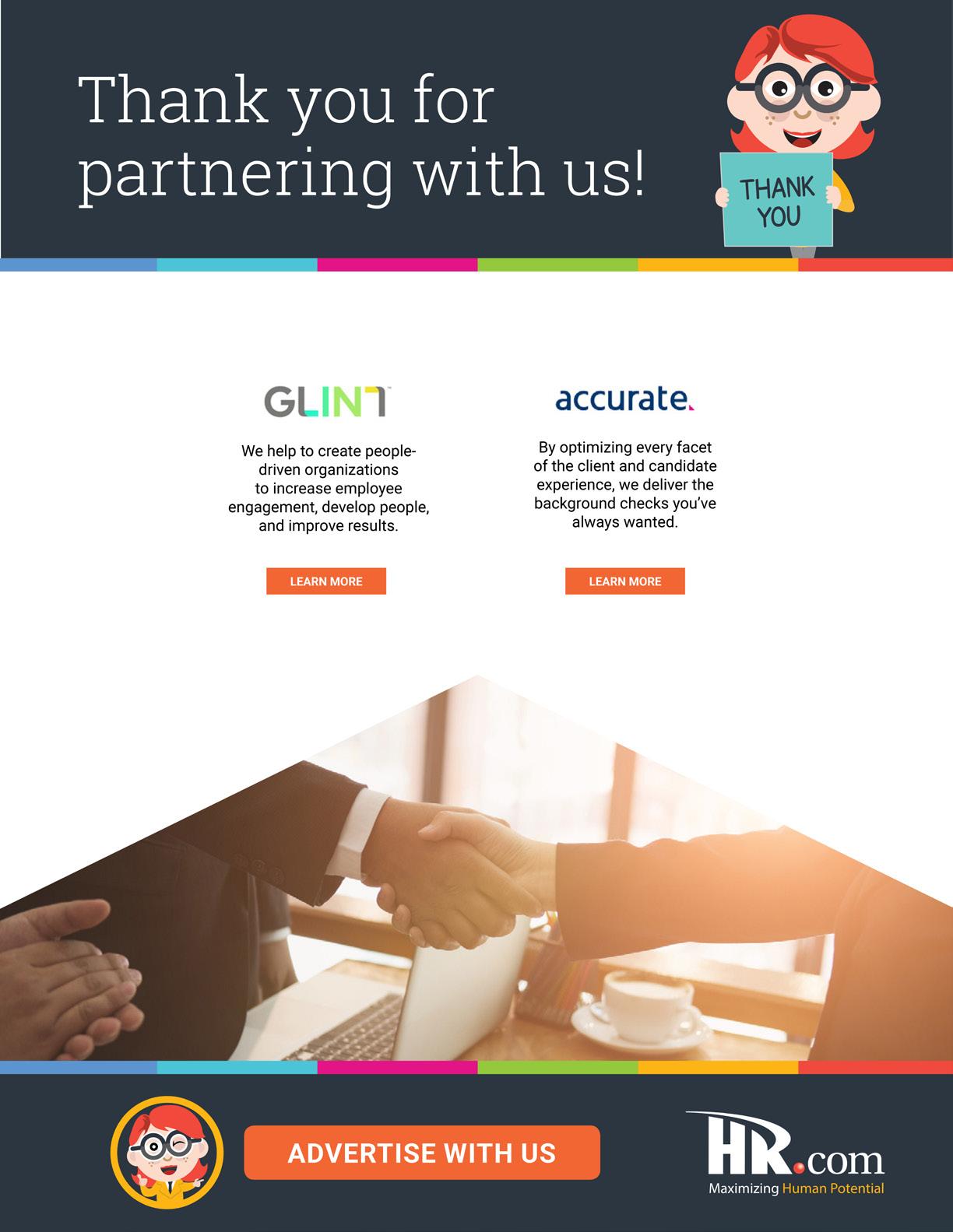
The Future of Coaching and Mentoring
April 5, 2023
The Future of Payroll: New Trends and Global EORs
April 20, 2023
Successful Talent Management Strategies From Hire to Retire
View our Upcoming Virtual Conference Schedule and Register Today!
April 26, 2023
Unlock Your Hiring Potential: The Predictive Power of Structured Interviews
April 4, 2023
Mentoring and Coaching in a Remote and Hybrid World April 5, 2023
2:00 PM - 3:00 PM ET REgIsTER WEBCA s T s v IRT u AL E v ENT s
April 13, 2023
April 19, 2023
Skills vs. CVs: The Power of Skills-Based Hiring in 2023
View our Upcoming Webcasts Schedule and Register Today!
REgIsTER
REgIsTER
REgIsTER
1:00 PM - 2:00 PM ET REgIsTER
12:00
1:00 PM ET REgIsTER
PM -
12:00 PM - 1:00 PM ET REgIsTER vIRTuAL EvENTs & HR.COM WEBCAsTs uPCOMINg
www.hr.com/virtualconferences
www.hr.com/upcoming_webcasts
WEBCA s T s
Unconventional Benefits With Sharlyn Lauby: What Does Your Workforce Really Want? 3:00 PM - 4:00 PM ET REgIsTER
The Bell Mentoring Program – Connecting Talent and Building Better Careers April 5, 2023

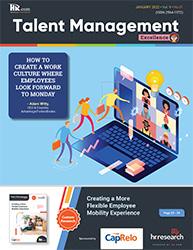
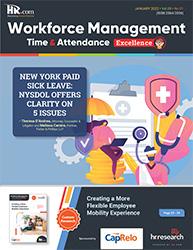




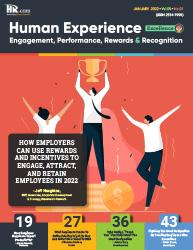



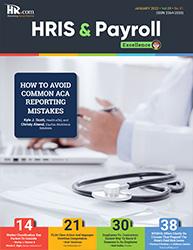

Like to submit an article? Use our online submission form or for more information go to www.hr.com/ExcellencePublications Publications 13 Targeted Publications to Reach your Audience Informing, Educating, Enlightening and Assisting HR professionals in their personal and professional development, the Excellence series offers high-quality content through the publications!

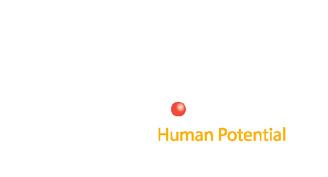
For more information: Phone: 1.877.472.6648 | Email: ePubeditors@hr.com | www.HR.com/epubs HCM Excellence (APAC & Middle East) March 2023































 Dave Ulrich
Rensis Likert Professor, Ross School of Business, University of Michigan Partner, The RBL Group
Julie Winkle Giulioni Author, Virtual /Live Keynote Presenter, Inc.’s Top 100 Leadership Speakers
Dr. Beverly Kaye CEO, BevKaye&Co.
Dave Ulrich
Rensis Likert Professor, Ross School of Business, University of Michigan Partner, The RBL Group
Julie Winkle Giulioni Author, Virtual /Live Keynote Presenter, Inc.’s Top 100 Leadership Speakers
Dr. Beverly Kaye CEO, BevKaye&Co.

 By Dr. Vidhya Thakkar, K J Somaiya Institute of Management
By Dr. Vidhya Thakkar, K J Somaiya Institute of Management















 By Vibhuti Duggar, Project Purpose
By Vibhuti Duggar, Project Purpose
























